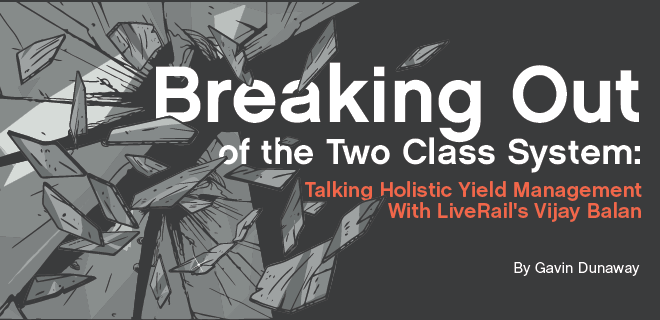
Match every impression with the channel likely to garner the most revenue – seems like the stuff of operational daydreams, but I’m not going to tell you to snap out of it. Such dynamic inventory allocation is real, oh-so-real, and it’s referred to as holistic yield management. I know that sounds like one more piece of empty industry jargon, but it’s actually a pretty appropriate name for what goes on.
Fortunately I had Vijay Balan, Head of Client Services at LiveRail, give me the lowdown on holistic yield management. In addition to defining the term, we deliberated on the revenue opportunities that should encourage publishers to forage beyond the direct/indirect divide and the compensation and organizational hurdles to dynamic inventory allocation.
GD: When I did a little research on holistic yield management, I was pleasantly surprised that it isn’t just a buzzword. This is a real thing, but it’s a little hard to describe. Is there a straightforward way you like to explain it?
VB: Sure. There is a lot of terminology out there: holistic yield management, dynamic allocation, etc. The reason we’re talking about holistic yield management today is because it really isn’t being done today. Publishers aren’t looking at their entire supply as a single sellable product, one they’re able to sell through different sales channels.
Because of the fragmentation of the marketplace, our ecosystem has forced publishers to think about selling their inventory in two distinct channels: direct and remnant. You end up with differing price points and weird ways in which inventory gets sold. It’s made it really hard for a publisher to do holistic yield management, and I think it’s time to reel that in.
I’m talking about a standardized way for a publisher to think about all of its inventory and allow controlled access to that inventory for maximum revenue. So not on a CPM basis, but on more of a holistic RPM basis, with R standing for revenue.
If I’m trying to convince a publisher to consider holistic yield management, there are basically two arguments. One is obvious — you want better deals. If you think about holistic yield management from a deals standpoint, the extra money is coming from the ability to attract a variety of advertisers by giving them exactly what they want. You’re increasing advertiser value, which is very important over the long term as a publisher business.
There’s another important vector: you can have relevant ads being served to the right people, meaning a better user experience. One of the things I always tend to think about when I think about programmatic is, “If only we could do a better job.” I watch a lot of tennis on connected TV, and halfway through Wimbledon the other month, I swore to myself I would never buy a certain brand of car. I have nothing against the brand, but I literally saw the same ad about 200 times. That’s not holistic yield management right there!
GD: What are the technological components that are required for HYM? Because I am turning it into an acronym.
 VB: Let’s start with what’s not working. If you’re a sales leader at a publisher organization, you’ve got people on your team selling your inventory, and they’re probably doing it in a very effective way, at a very high CPM. And then your inventory management team is basically telling them, “Hey, you don’t know what the traffic patterns are going to look like. Sell 85%; let’s take 15% and call it remnant, and sell it for cheap,” when it’s the exact same inventory.
VB: Let’s start with what’s not working. If you’re a sales leader at a publisher organization, you’ve got people on your team selling your inventory, and they’re probably doing it in a very effective way, at a very high CPM. And then your inventory management team is basically telling them, “Hey, you don’t know what the traffic patterns are going to look like. Sell 85%; let’s take 15% and call it remnant, and sell it for cheap,” when it’s the exact same inventory.
And I think that’s one part of the technology problem — we have a two-class system. You’ve got programmatic that is specifically generated for the remnant space, and you’ve got programmatic software and technology that focuses on your direct business. That needs to change. You need a platform that syncs up your inventory as a whole and drives value by providing access to the right advertisers.
GD: So with holistic yield management, is it really about a single ad server for everything?
VB: I like to call it a primary decisioning layer. When Lisa comes to my site, I make the first and last decision on which ad gets served. I don’t look at my direct orders first and then pass it on to another demand source, and then they pass it along to 10 other people, and then I get an ad from the eleventh person. Instead, I allow the decisioning layer to decide which ad is going to add most value for me as a publisher, most value to the advertiser and the best user experience.
It’s all about people. You have Lisa on your site. Auto Car brand pays a $15 CPM to reach her on your site. But then Lisa is also in the remnant bucket, where Classic Computers is reaching her for a $3 CPM. It’s the same person! For the publisher, creating content that attracts Lisa is the same cost. But the publisher hasn’t done a great job of matching supply and demand.
Ultimately, you have to understand who in order to understand what you’re going to serve to that person. The lack of that knowing who people are on your website has to some extent driven the siloed system we have today.
GD: Tell me about the people behind the technology. What’s really required of ops personnel to effectively run holistic yield management?
VB: First, a publisher has to remove sales-channel conflict by aligning sales and compensation strategies. I believe sales people should be compensated on advertiser spend. Salespeople should be incentivized to get advertising spend through any channel. Then they can say to the advertiser: You want to give me an IO? Great. You want your DSP of choice to execute it? Great. Ultimately, all of this is my inventory.
It’s a new way of thinking about revenue attribution and value. Don’t worry about where the dollar actually executes; worry that the money is flowing through the pipes from the brand. Today, a sales person is highly focused on, “Hey, can you give me an IO, because that’s what makes me money?” You need to have a conversation about why a publisher’s property is a good fit for you to spend. You really want to advertise with us, and don’t worry about how you transact.”
Second is an organizational change. Today we’ve got two sets of ops people at a publisher: direct sold and programmatic strategy. You’ve got people in organizations with titles like “director of programmatic,” which may mean a lack of understanding about what you want to use programmatic for – controlling access to the buyers you want or don’t want to work with.
You need to start thinking about your operations and your operating strategy as being a single, unified, holistic yield management operations strategy. Make sure you’ve got as many pipes as you can in the ecosystem to the buyers, and make sure they are clean and operational. Encourage advertisers to execute any way they want. You’re going to see your prices rise. You’re going to see a more democratic process. Advertisers are going to find more value in working with you.
The last point is tech. Users are moving rapidly from desktop to mobile. Mobile is hard enough in itself, but then you’ve got multiple devices, a variety of players for video, tablets, etc. You want someone who really understands where people are consuming their content today.
GD: So you think the days of the publisher programmatic specialist are numbered?
VB: I think that they should be given a broader mandate, and they should be more integrated into the operations strategy.
GD: I’m wondering what makes pubs nervous about moving to holistic yield management, other than major organizational changes. For example, direct-sold, guaranteed campaigns are generally held sacred: “Oh, I can’t under-deliver, I can’t under-deliver!” How do you assuage such publishers fears?
VB: I challenge the notion that you’ve got this direct campaign that always needs to run full and first. I have no evidence that opening up your inventory to everyone out there makes you less money! To take a slightly contrarian view, a publisher at the end of the day is trying to make as much money as they can. The only way you would under-deliver on an order you’ve got guaranteed is to get someone else to beat that order out for more money. I have yet to find a sales leader that does not like more money.
So you’ve got to weigh your priorities. You’ve got to redefine the relationships you have with your advertisers. You’ve got to make them compete. If a specific brand’s campaign is under-delivering, they might need to pay more. Once you have holistic yield management, you’re going to see buyers really step up their game. The redefinition of the relationship with the advertiser means you should stop thinking about how many dollar you can extract from them, and move onto how much value can advertising on your media align with their business outcomes.
GD: I’m a publisher and I’m going to take the plunge. I’m going to adopt holistic yield management tomorrow. What’s the first thing I should be doing?
VB: We spoke about the conversations you need to have around sales compensation and operations. First, get everyone on the same page. Is your sales team feeling empowered? Does ops feel like they have more control over the publisher’s destiny? Do you have the right tech platform? If you’ve got those three things right, you’re trying out software.
GD: Do you think publishers should experiment with changing priorities so private exchanges or open marketplaces come above direct?
VB: That’s a good way to think about it. I’ve seen good things come out of publishers testing along those lines. A private exchange is a really good first step to holistic yield management. It allows publishers to build muscles they didn’t have and work with advertisers in a programmatic way. It allows publishers to control access and test out higher prices, while getting them comfortable with the concept of working with advertisers in a new programmatic way where both parties are able to bring their data. The publisher and advertiser are working on a project together.